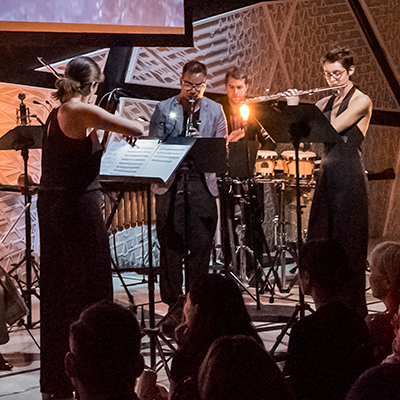By Marilou Carlin
Long a core component of SMTD’s music curriculum, chamber music has lately taken center stage as the place where innovation and career development come to thrive.
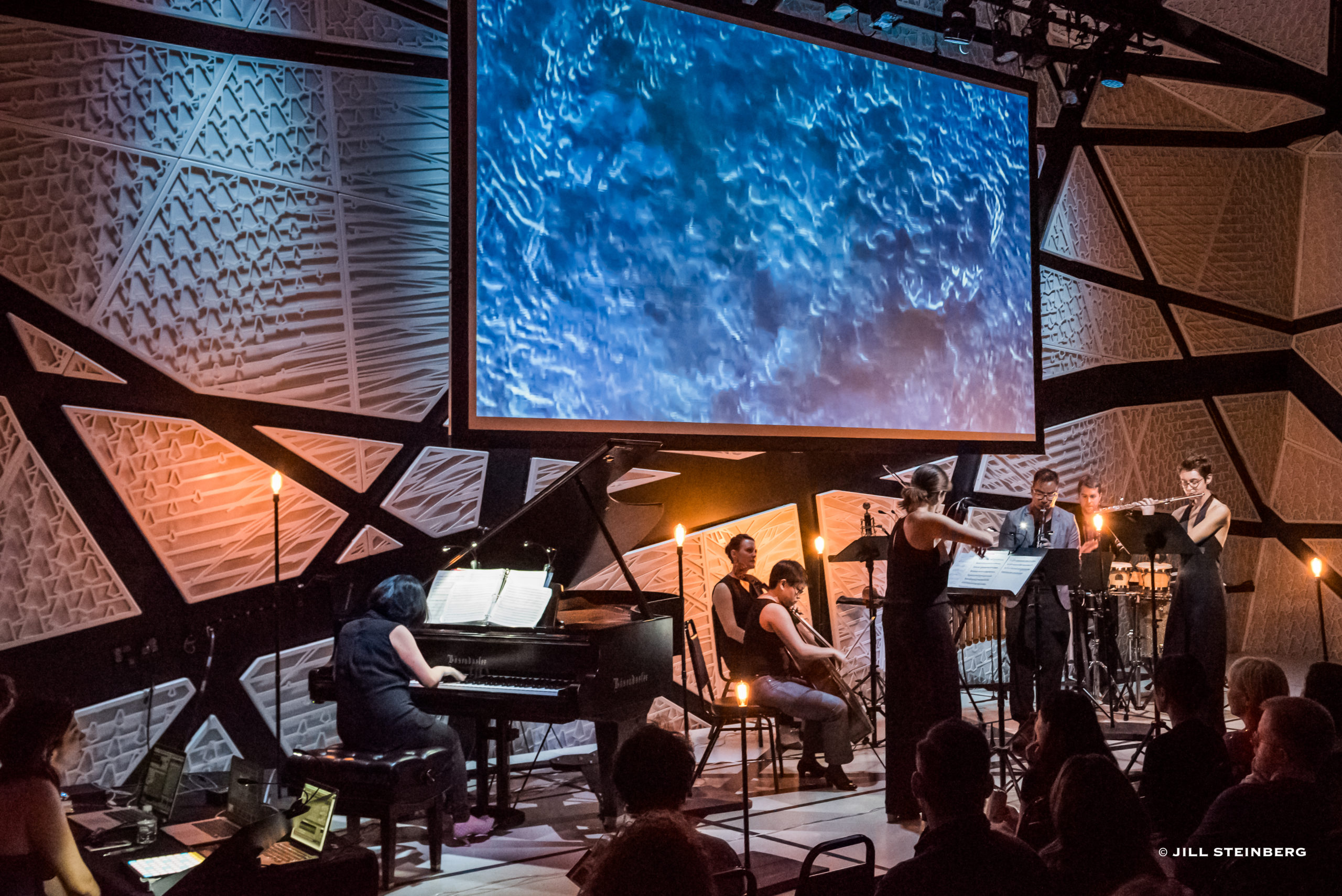
Khemia Ensemble is focused on championing the works of living composers through vivid, multimedia performances. The ensemble fosters collaboration among the arts by working closely with designers, visual artists, and writers as well as incorporating poetic, visual, and interactive elements in their performances. The alumni members are resident composer and executive director Carolina Heredia, DMA ’16 (composition); resident composer and artistic director Bret Bohman, MM ’11 (composition); ensemble manager and percussionist Chelsea Tinsler Jones, MM ‘16 (percussion); soprano Amy Petrongelli, MM ‘11, DMA ‘16 (voice); percussionist Shane Jones, DMA ‘17 (percussion); and pianist Siyuan Li, MM ‘13, DMA ‘16 (piano). Additional members are Thiago Ancelmo, clarinet; Eli Lara, cello; and Mary Matthews, flute.
“Chamber music offers us the opportunity to play and explore in our very own new music sandbox, where the possibilities are endless and the process is full of joy, curiosity, and friendship.”
That’s how Jani Parsons, pianist and music director of the new music sextet Latitude 49, summed up her group’s love for their chosen music genre. The mixed chamber ensemble (piano, violin, cello, saxophone, clarinet, and percussion) was founded at SMTD in 2012 and makes new music the cornerstone of their mission. With a busy performing schedule that takes them around the country, frequent residencies at top music schools, extensive educational outreach, and innovative recording projects, Latitude 49 is emblematic of the ambitious and successful chamber ensembles that have formed at SMTD.
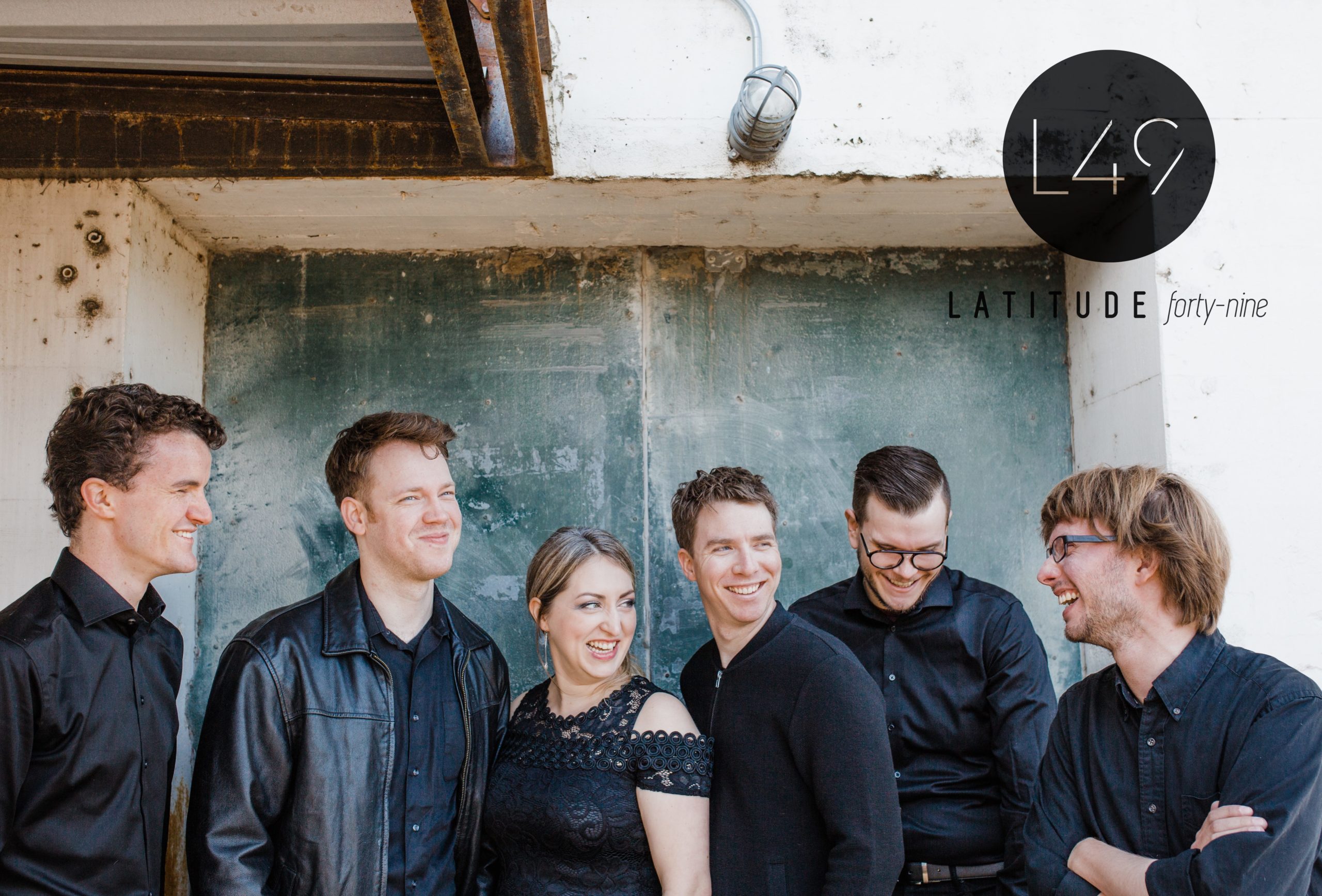
Blending the finesse of a classical ensemble with the drive and precision of a rock band, Latitude 49 has commissioned and premiered 50+ works by living composers, touring nationally and presenting concerts in major venues including the Ravinia Festival (Chicago), (le) poisson rouge (NYC) and the Music Box at the Max M. Fisher Music Center (Detroit). The group comprises SMTD alumni Jani Parsons, MM ‘10, DMA ‘13 (piano); Timothy Steeves, BM ‘12, MM ‘14 (violin); Andy Hall, MM ‘11 (saxophone); Max Geissler, MM ‘11 (cello); and Chris Sies, MM 12, MM ‘15 (percussion); as well as clarinetist Andy Hudson.
SMTD chamber groups, both student and alumni, are excelling in traditional formats and also creating unique instrument combinations. In the process they’re winning major awards, including Fischoff Medals; commissioning a vast array of new music; creating music festivals on the international stage; making groundbreaking recordings; and connecting with communities in ways that only small, self-driven, and diverse ensembles can. “Chamber music is a field that is limited only by our students’ ambitions,” says Matt Albert, chair of the Department of Chamber Music and the former violinist/violist with Eighth Blackbird, a group that shook up the genre by concentrating on new music and unexpected collaborations.
Albert now oversees SMTD’s chamber music degree program, a master’s degree designed to be acquired in tandem with a traditional performance degree. He was also the artistic director of the M-Prize Chamber Arts Competition, which SMTD hosted for three years. The competition was discontinued earlier this year at the conclusion of the funding commitment from the Office of the Provost.
“M-Prize inspired me to think about the big picture of chamber music and how Michigan could highlight the success stories,” says Albert. “It showed us how much is happening across the spectrum of chamber music, in all traditions and styles. We’re asking ourselves how we can use our current resources to focus on the projects that students are devising, and the opportunities are just incredibly exciting.”
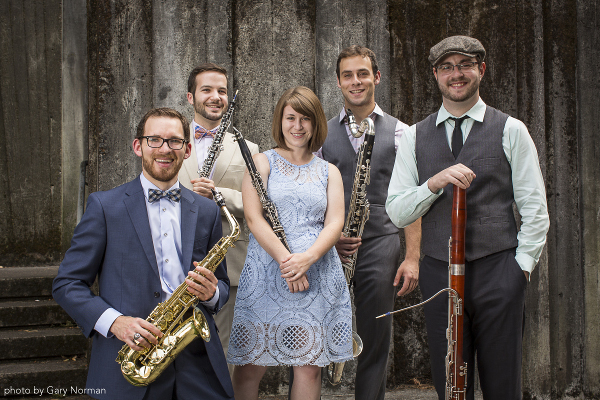
Founded in 2009, Akropolis is the first reed quintet in history to win the Fischoff Gold Medal (Senior Winds), the Fischoff Educator Award, and seven national chamber music prizes in total. The group created Together We Sound, a contemporary music festival in Detroit supported by the National Endowment for the Arts. They have premiered more than 50 new works and recorded three albums. The ensemble’s members are Matthew Landry, BA ’10 (music education); Tim Gocklin, BM ’12 (oboe); Andrew Koeppe, BM ’10 (clarinet); Kari Landry, BM ’11 (clarinet); and Ryan Reynolds, BM ’12 (bassoon).
The foundation for such a robust and expansive chamber music program at SMTD was laid during Christopher Kendall’s tenure as dean (2005-2015). Kendall, himself a longtime chamber musician, carefully recruited exceptional faculty members whom he knew would contribute substantially to enhancing and growing the program.
Kendall’s successor, Aaron Dworkin, who served as dean from 2015-2017, further committed the School to chamber music. He created the Department of Chamber Music, hiring Albert to chair it, and launched the School’s EXCEL program (Excellence in Entrepreneurship, Career Empowerment & Leadership) as well as M-Prize. Meanwhile, David Gier, who took over as dean in October, is a faculty member of the Chamber Music Department. This appointment reflects his own expansive experience as a chamber musician, including many years as a trombonist in the Iowa Brass Quintet.
Chamber Music as Teacher
If defined as a small ensemble with no conductor, where members take full artistic and logistical responsibility, chamber music is inherently entrepreneurial.
“Students are empowered to make artistic, scheduling, and project-oriented decisions as chamber musicians,” says Albert. “It’s a different way of learning.”
The EXCEL Lab, then, has become a natural ally and important supporter of many SMTD chamber ensembles, providing mentorship, guidance, and monetary support for projects. It’s no surprise that the rise of EXCEL has paralleled an increase in ensembles that are engaging in active marketing, outreach, and other entrepreneurial activities. Two of the four groups who received EXCELerator Fellowships this year – which comes with $1,000 in seed money to pilot their ventures – are chamber ensembles.
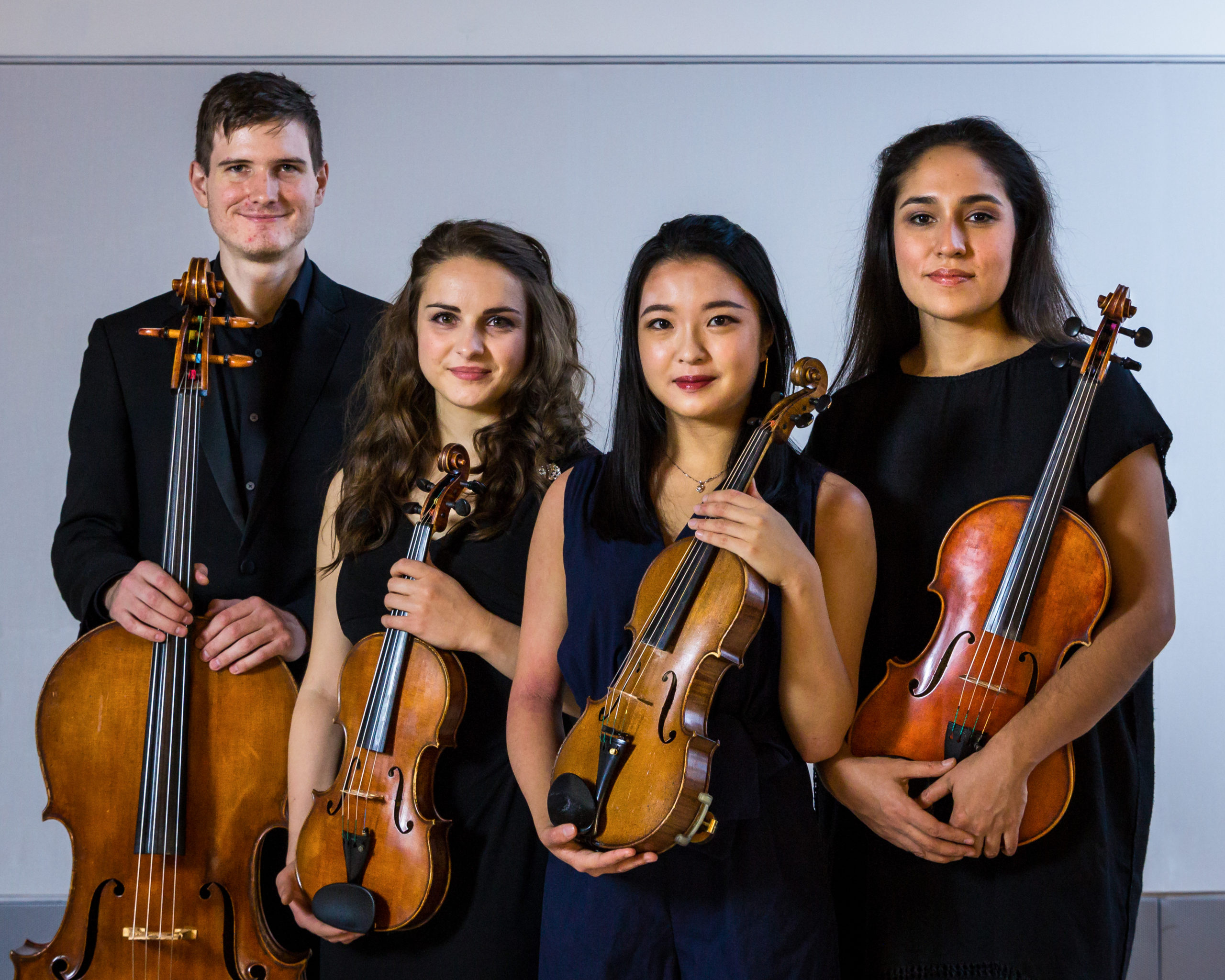
Current students Gwendolyn Matias-Ryan (viola) and Christine Showalter (violin) as well as alumni Aaron Baker, MM ‘19 (cello) and violinist Pauline Ng, MM ‘19 (composition) formed the Amatista Quartet in 2015 and received an EXCELerator Fellowship this year to launch a chamber music festival, titled SA’, in Oaxaca, Mexico (in partnership with the Facultad de Bellas Artes – UABJO and the Fonoteca Juan León Mariscal – Centro Cultural San Pablo). The quartet has a special mission to perform and promote the music of Latin-American composers.
But beyond developing business savvy, student chamber musicians also learn how to listen, negotiate, disagree respectfully, build consensus, and create structure where there is none – invaluable skills in music and every other area of life.
“I believe so much in the power of chamber music to build trust and communication,” said Joseph Gramley, chamber music faculty member, director of SMTD’s percussion studies, and a member of Yo Yo Ma’s Silk Road Ensemble, one of the world’s most renowned chamber groups. “At its core, chamber music is about collaboration and a flat hierarchy. And in our world at this time, and at all times, that’s very important. It gives the collaborators a voice and it allows chamber musicians to express themselves in many different ways, with understanding, trust, empathy, patience. It allows the player to learn about the other.”
Albert agrees. He believes that faculty must teach not only the technical elements of chamber music – how to balance a chord, play in tune, cue one another to play in rhythm – but also group dynamics: how to listen to one another and empower voices.
“That’s a really big thing,” said Albert. “In small group work, you can clearly, and with compassion and empathy, address power dynamics, including those based on race, sexuality, and gender identity. In small groups it’s so much easier to have a really candid conversation about who is talking more, who is not listening, who is not being heard. How can we hear each other more, and then model behavior that people can, hopefully, take outside those small groups?”
In harnessing entrepreneurial as well as communication skills, students are proving that chamber music is not an archaic relic of past centuries, but one of the most relevant music forms of the 21st century.
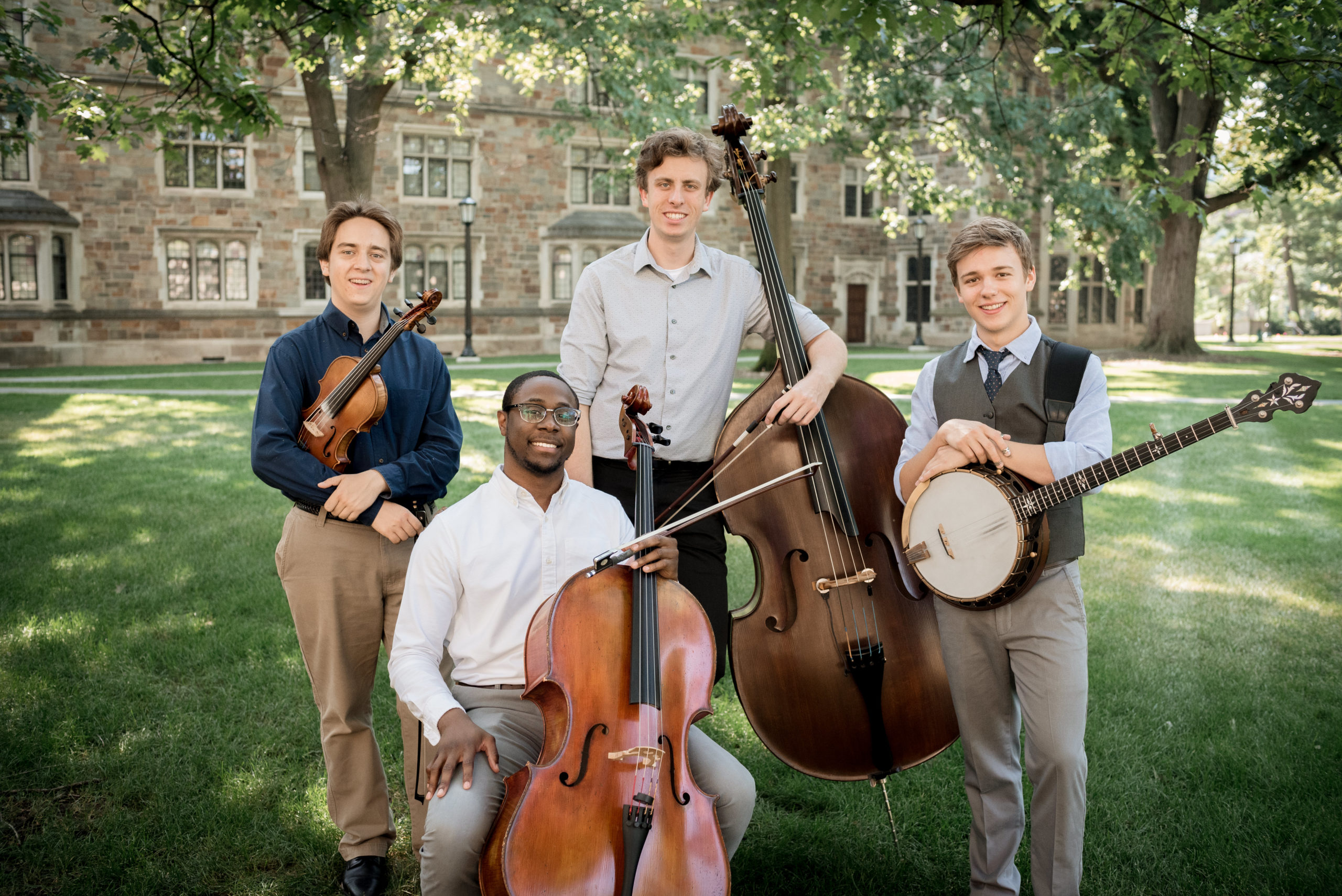
Westbound Situation blends the precision of classical chamber music, the rhythmic drive of bluegrass, and the colorful expression of jazz into a new style of chamber music: chambergrass. Composed of undergraduates Grant Flick on violin and Matt Davis on banjo, Jacob Warren, MM ’19 (chamber music), MM ’19 (improvisation) on bass, and cellist Zach Brown, the group mixes composition and improvisation seamlessly into their entirely memorized arrangements. As a trio, without Brown, Westbound Situation was the First Prize winner of the 2019 Briggs Chamber Music Competition at SMTD.
“Every way you look at chamber music, it’s relevant in the modern world,” says Jacob Warren, founder of Westbound Situation, a quartet comprising bass, violin, cello, and banjo that plays what the members describe as “chambergrass,” a melding of classical, jazz, and bluegrass styles. “Financially, it is more profitable to travel and perform in small ensembles, and logistically it is easier to coordinate travel with a smaller group. Above all, though, chamber music is a reflection of our times. A chamber ensemble is the sum of the individual musical and personal experiences of its members. With unique flexibility, chamber ensembles are able to explore the intersection between many different musical styles and experiences.”
This sentiment is echoed by Ben Jackson, the violinist of Front Porch, a student ensemble comprising piano, percussion, bassoon, and violin, and one of the 2019 EXCELerator Fellows. “Chamber music has a unique ability to form a personal and interactive connection between performers and audiences, and as a result, is a powerful tool for sharing the stories of people from diverse backgrounds,” he says.
Both of these groups have unique instrumentations, but traditional chamber groups, like string quartets and piano trios, continue to thrive. However, the traditional aspect of these ensembles is often limited to its instrumental makeup.
“Chamber music at Michigan has retained its core classical Western music foundation, but it’s gone in a lot of other directions,” said Gramley. “One of the things I love about the program is that so many of the groups are not traditional in any sense – instrumentally, culturally, racially, gender-based. Many other great institutions have an amazing history of chamber music in a classical Western art music sense, but our program has so much that’s new, different, and unique.”
The Small Ensemble Journey
Chamber music begins early in the life of a Michigan student musician, who may elect to participate in an ensemble as early as freshman year. “Our job is to encourage students to develop an interest in the collaborative arts,” says Amy I-Lin Cheng, lecturer of piano and the piano chamber music coordinator. “Our main goal is to expose students to great chamber music education and performance experiences, especially in off-campus venues, and provide opportunities for public speaking. And for those who have long-term [ensemble] plans, we have the resources and ways to help support them, to take their potential career in chamber music to the next level.”
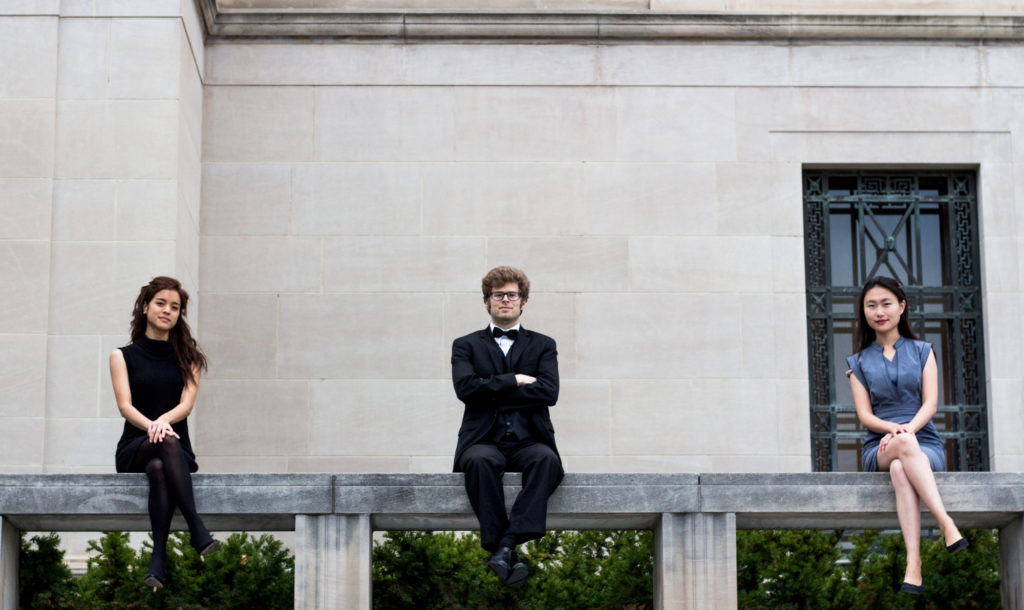
Consisting of DMA student Christine Harada Li, BM ‘12, SP ‘17 (violin), Nathaniel Pierce, BM ‘13, DMA ‘19 (cello), and Hye-Jin Cho, MM ‘18 (chamber music), DMA ‘18 (piano), the Koinonia Trio was formed in 2015. The group won first prizes at the 2017 Briggs Chamber Music and the East Central MTNA Chamber Music competitions, and was awarded an SMTD EXCELerator Grant Fellowship as well as a $10,000 grant from SMTD’s Binkow Endowment for Chamber Music. The trio has toured Europe, performed across the U.S., and was an ensemble-in-residence at the Innsbrook Institute and the Anchorage Chamber Music Festival.
Each semester Cheng organizes between 20 and 25 piano ensembles (consisting of a pianist and other instrumentalists) while her counterparts in strings (Andrew Jennings and Kathryn Votapek), wind instruments (William Campbell, William King, and Timothy McAllister), and percussion (Joseph Gramley) do the same for their areas. Some students form their own groups. Ultimately, between 55 and 60 student ensembles are formed each semester, “each of which has its own trajectory, its own goals, its own place of where it fits in the curriculum,” says Albert. “There’s a lot of energy, a lot of possibility, a lot of success and a lot of failure – and I don’t think failure is a bad thing. This is the place where the more you try something, and you don’t know if it will work, the more you learn.”
The breadth of what the students play within their ensembles is dazzling. It includes everything from early music (coached by Professor Joseph Gascho) to the core classical repertoire of the 18th to 20th centuries, to contemporary and even improvisational work. Like Westbound Situation, there are also groups playing “crossover” styles or focusing on adapting or commissioning music for new combinations. One current ensemble features bagpipes, and another is a piano/percussion duo. The Admiral Launch Duo, comprising alumni Jonathan Hulting-Cohen, BM ’12, MM ’14 on saxophone and Jennifer Ellis, DMA ‘15 on harp, was founded at Michigan.
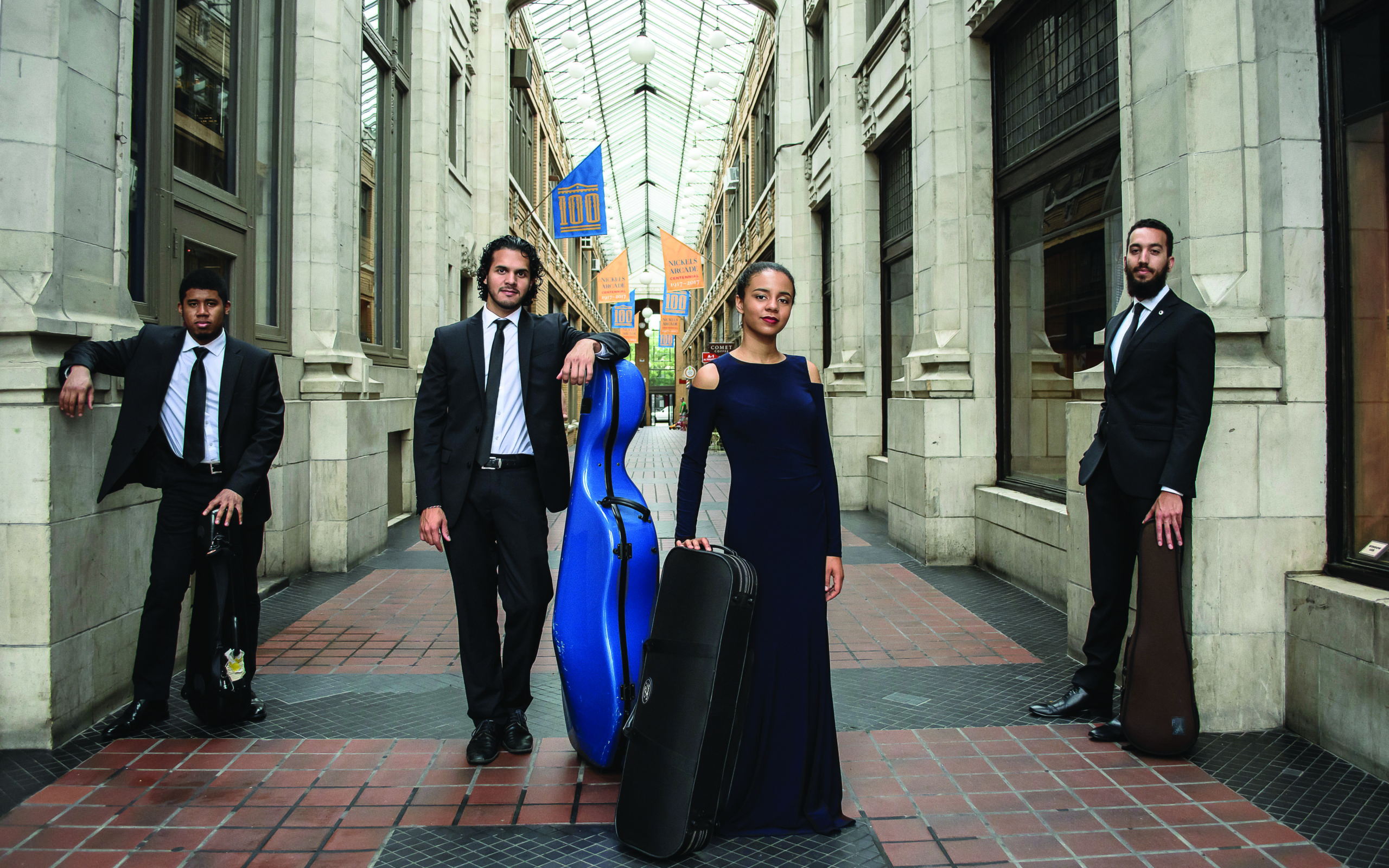
Founded in 2016, the Ivalas Quartet comprises violinists Reuben Kebede and Anita Dumar, BM ‘18, violist Caleb Georges, MM ’19 (viola), MM ’19 (chamber music), and cellist Pedro Sanchez, MM ‘18, all current graduate students. They were awarded First Prize in the 2018 Briggs Chamber Music Competition, and named a semifinalist group at both the M-Prize competition and Concert Artists Guild competition in New York. They were also quarter finalists in the senior strings division of the 2019 Fischoff Chamber Music Competition.
But traditional ensembles still dominate, and most students focus on a mix of canonical and new repertoire, which has led to major accolades for some, such as the Ivalas String Quartet. All musicians of color, the quartet won first prize in SMTD’s 2018 Briggs Chamber Music Competition and represents the Sphinx Organization in playing for young audiences in Detroit and Flint. The quartet won the senior division of the 2019 WDAV Young Chamber Musicians Competition and, along with SMTD’s Sapphirus Saxophone Quartet, made the quarter-finals of the 2019 Fischoff Chamber Music Competition.
New music is key to many ensembles, both student and alumni, and at SMTD, home to an exceptional composition department, collaborative opportunities with young composers abound. For composers, chamber works – as opposed to large ensemble compositions – are far more flexible to organize, so it’s a win-win situation. To that end, Professor Evan Chambers, a member of the chamber music faculty, matches student composers with players in the various instrumental studios, resulting in the annual CoLab Concert.
At the same time, alumni ensembles, such as the Akropolis Quintet, the Donald Sinta Quartet, and Latitude 49 all maintain relationships with composition students and alumni, and regularly commission their work.
“Ensembles are commissioning more than ever before, for many reasons,” says Gramley. “First, these ensembles are often unique groupings of instruments, so there’s not a lot of repertoire. Plus, it makes the group unique to have pieces written for them. This great relationship between composers and artists who play new music gives both sides a way to integrate.”
In addition to playing new music, chamber ensembles are also helping the field evolve by connecting with communities and finding new audiences. It’s a practice that begins when they are students.
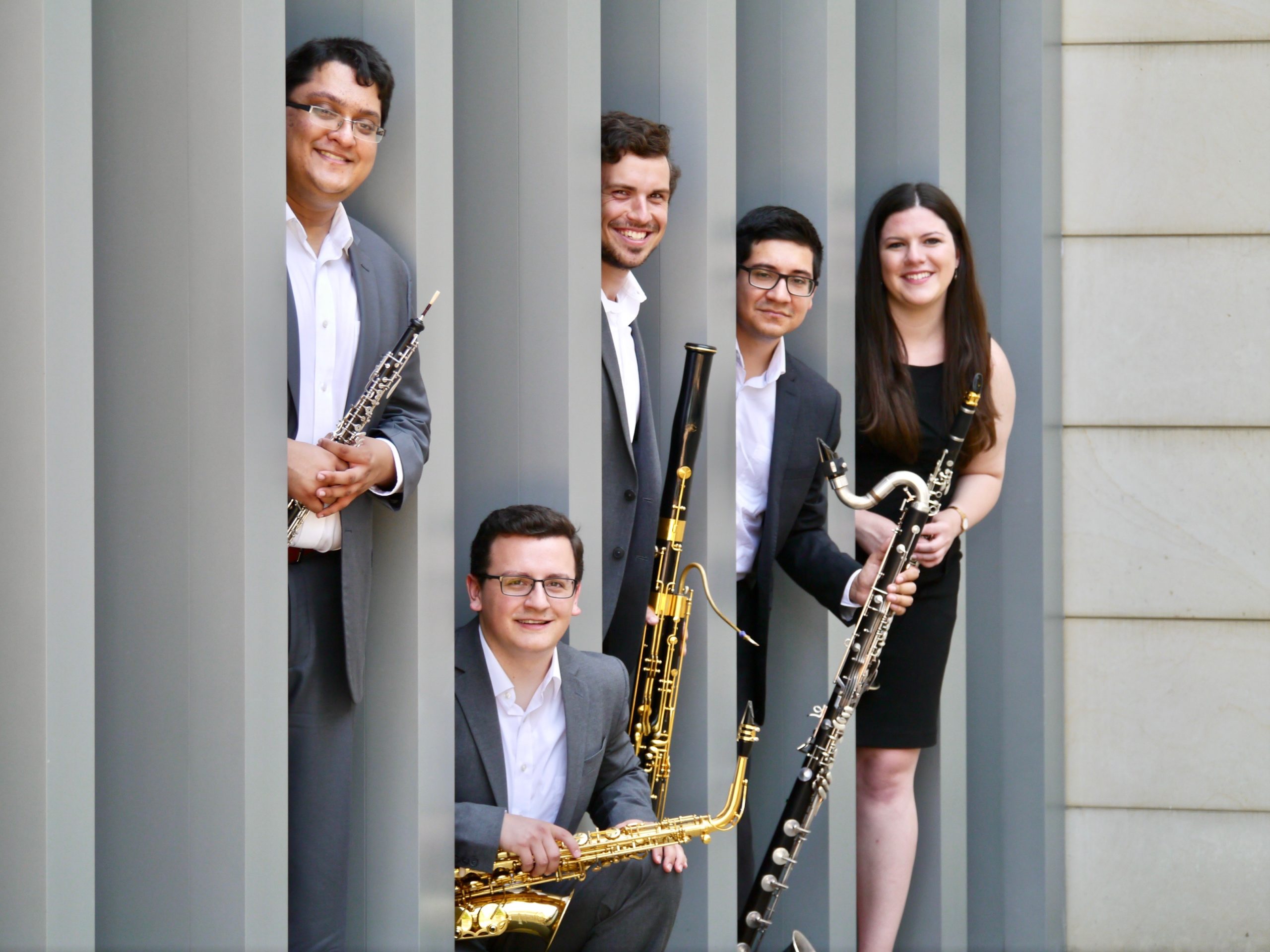
Founded at U-M in 2017, the Vanguard Reed Quintet is committed to breaking new musical ground, increasing the depth and diversity of the reed quintet’s core repertoire, and engaging audiences with innovative, adventurous, and inspiring musical experiences. The group’s current members includes Sagar Anupindi, BM ’18 (oboe); Mickayla Chapman, MM ’18 (clarinet); Sean Meyers, MM ’18 (saxophone); and Joseph Swift, MM ‘17 (chamber music and bassoon). They are joined by Nico Chona on bass clarinet.
In SMTD’s piano chamber program, students perform nine concerts off campus: four in Kerrytown Concert House in a series titled “Mad About Chamber Music,” funded by an anonymous donor, and five at the Bloomfield Public Library, which videotapes and broadcasts the recitals on local television.
But students also initiate their own outreach. Front Porch, with funding from SMTD’s Performance Engagement Educational Residencies (PEERs) Program, created a semester-long partnership with Detroit Leadership Academy, presenting workshops that explored creative storytelling through music under the mentorship of the acclaimed Chicago-based Fifth House Ensemble. And Connor Darling, BM ‘19 (percussion) and rising senior Sofia Carbonara (percussion) launched an all-arts presenting
organization, titled Plant the Seed, to promote improvised chamber arts in Southeast Michigan.
“We are passionate about process-oriented performance, where active listening and shared creativity are prioritized over the more traditional, hierarchical, object-based concert experience,” said Darling. “Through our monthly concert series and rotating special events, we create spaces for improvisation-based artists and community members to connect. We hope to expand our reach in the next year in order to impact more diverse communities and include a larger number of artists.”
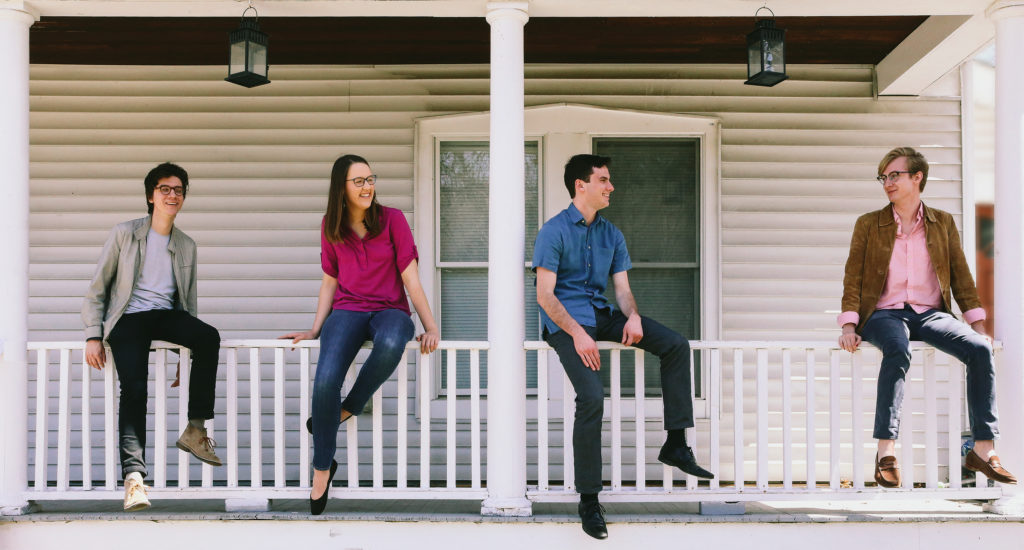
Comprising Ben Jackson, BM ‘19 (violin), Maddy Wildman, BM ‘19 (bassoon), Jacob Rogers, BM ‘19 (composition) on percussion, and rising senior Karalyn Schubring (piano), Front Porch invites audiences to engage personally with music by reimagining the classical concert experience with warmth and love as its foundation. The group won Third Prize at the 2018 Dale and Nancy Briggs Chamber Music Competition and are serving as the 2018-19 Young Ensemble-in-Residence for Detroit Chamber Winds and Strings.
Community outreach is vital to the success of all the alumni groups. They apply their entrepreneurial skills to connect with new audiences, discover new venues, and present in innovative formats.
“Chamber ensembles have the unique opportunity to impact communities in a more intimate setting and break away from the typical classical concert format,” said Chelsea Tinsler Jones, the percussionist and manager of Khemia Ensemble, which includes percussion, voice, flute, clarinet, cello, and piano. “Khemia is committed to innovating this experience by incorporating multimedia
elements, conceptual and thematic programming of a diverse and representative array of composers, and directly interacting with our audience through question and answer sessions after our performances.”
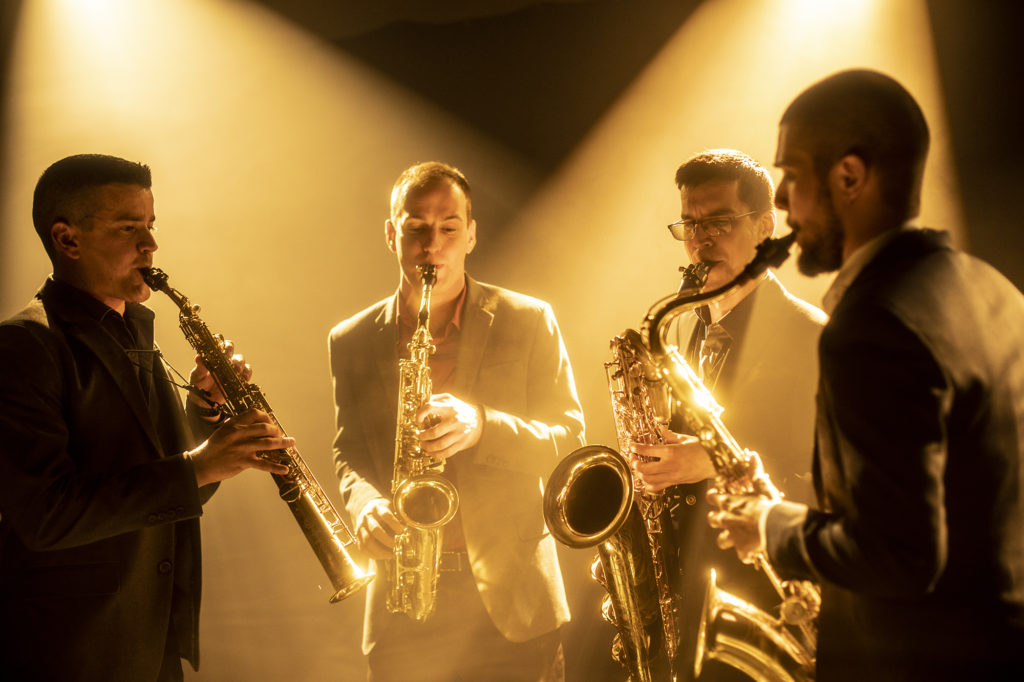
Senior Winds Gold Medalists at the 2018 Fischoff Chamber Music Competition, the saxophone quartet DSQ (Dan Graser, DMA ‘12; Joe Girard, MM ‘12; Zach Stern, BM ‘12, MM ’14; and Danny Hawthorne-Foss, MM ‘14) formed at SMTD in 2010 and has steadily amassed awards and accolades. The group performs at top venues and music festivals internationally, engages in extensive educational outreach activities, and runs a Saxophone Quartet Composition Competition, with two new works selected annually from up-and coming composers. Their debut album, Collider, will be released soon.
The Donald Sinta Quartet (DSQ), the award-winning saxophone ensemble named after the legendary SMTD professor emeritus, has made educational outreach key to its mission. “Performing in the community can inspire new generations of musicians, provoke discussion, help the public to understand why we do this, and, much more simply, just provide an enjoyable evening during a stressful time in people’s lives,” said DSQ spokesperson Dan Graser. “Having performed at crisis centers, drug rehab clinics, women’s shelters, public schools, and for university students, we have seen these possibilities firsthand and have become better musician-citizens as a result.”
Bringing chamber music to such varied audiences has taken the genre far from its European roots, as music that was played at home or in a private room or auditorium.
“We can adapt to most any venue, traditional or unconventional, which allows us to reach a wide audience,” said Jani Parsons. “Chamber music is the most dexterous and flexible form of musical collaboration I know of, and that speaks to the needs of contemporary musicians today.”

